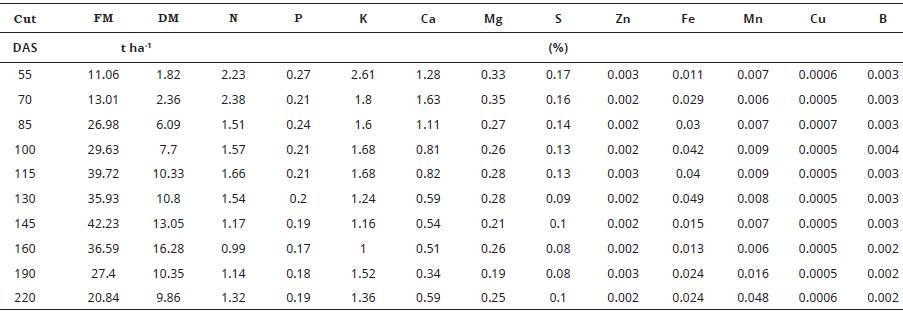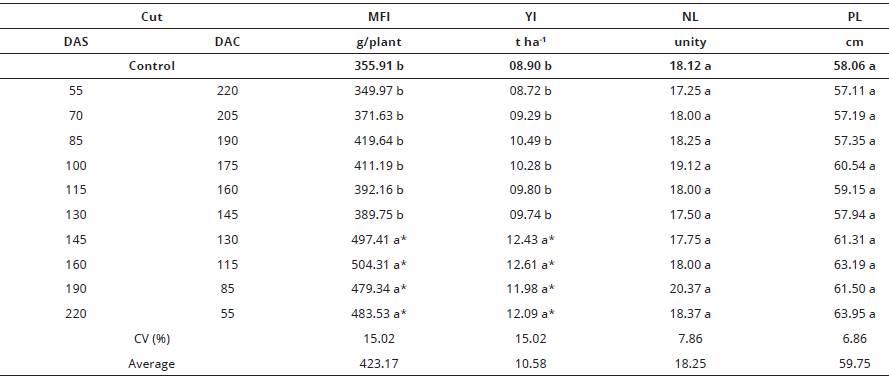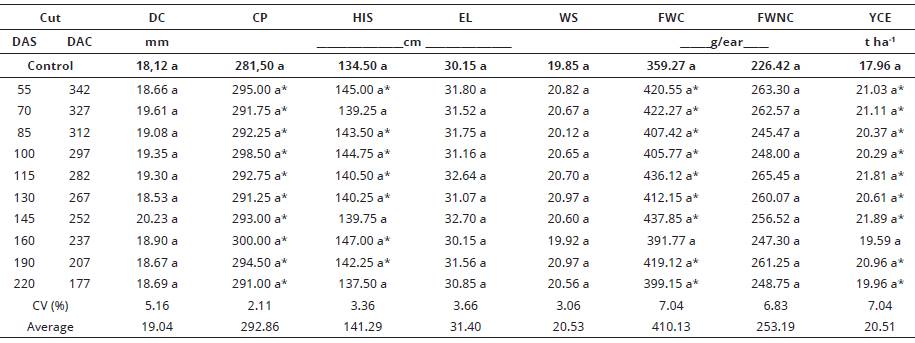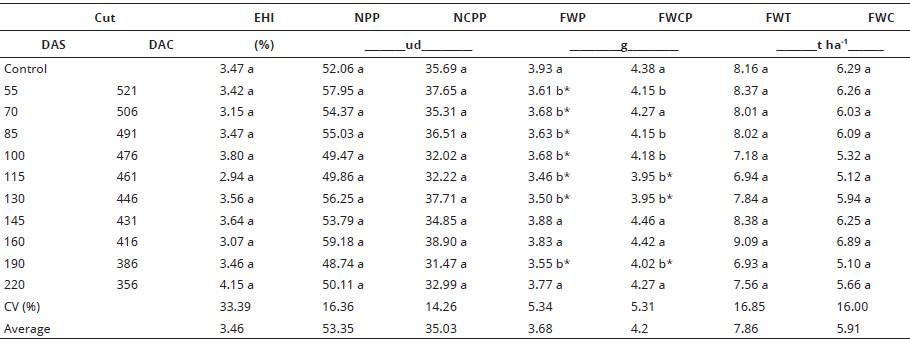Introduction
Vegetables are highly nutrient-demanding crops, and high yields are usually dependent on the application of high doses of fertilizers, especially nitrogen fertilizers, raising the cost of production. There are several studies on legumes as green manure vegetable crops (Puiatti et al.,2015; Zandvakili et al., 2017; Diniz et al., 2017; Adekiya et al., 2019), indicating a reduction in the need for nitrogen fertilizers (Yao et al., 2017). However, it is necessary to develop combinations of species and management forms that associate the availability of N of the legume and organic matter to the needs of the vegetables to synchronize the mineralization and the nutrient demand by the plants during the growth. Short cycle crops when cultivated in a consortium with green fertilizers, only part of the N derived from the mineralized green manure could supply the nutritional demand of the intercropped crop, another part may be available for subsequent crops.
The average decomposition time of 50% of the dry matter of the green manure Crotalaria júncea was 98, 102 and 120 days at doses of 03, 06 and 09 t ha-1, respectively. Regarding mineralization, it was fast in the initial phase of the process and 150 days after the application of green manure, more than 80% of the N initially applied via green manure had already been mineralized at all doses (Diniz et al., 2017). In taro (C. esculenta)- sunn hemp (C. júncea) intercropping with sunn hemp cuts close to the ground and taro canopy height reached during the cycle, it was reported a lower production of mother rhizomes and large commercial sprouts of taro in cuts of sunn hemp performed after 105 (Puiatti et al., 2015), indicating that even with nine months of taro cycle, there was still green manure material in the soil to be mineralized, suggesting the prolonged residual effect of green manures can be evidenced in sequential crops in the same area.
Studies show the residual effect of green manures on immediately subsequent cropping. There is a report of the effect of C. júncea mass doses applied in broccoli crop on the zucchini- corn succession (Diniz et al.,2017); residual effect of Hordeum vulgare, Pisum sativum, Crotalaria júncea and Fogopyrum esculentum on lettuce successive cropping (Zandvakili et al., 2017) and the effect of Moringa oleifera and Prosopis africana on okra (Abelmoschus esculentus (L.) Moench) successive cropping (Adekiya et al., 2019).
The sequence taro, broccoli, corn and pea during two agricultural years is a rotational system that fits the climatic requirements of the species and is coherent to crop diversification of familiar farmers of this region. The objective of this work was to evaluate the residual effect of the taro-sunn hemp consortium, cut at different times, on broccoli, green corn and pod pea subsequent cropping.
Material and methods
The experiment was conducted in the field of the Department of Plant Science at the Federal University of Viçosa, Minas Gerais, Brazil, in red-yellow Argisol Cambic soil, clayey texture class (28% sand, 17% silt and 55% clay), located 650 m high above sea level, 20°45’47” S and 42°49’13” W. According to the Koppen classification, the climate is humid subtropical (Cwa), with an annual average of 1,341 mm of pluvial precipitation and maximum and minimum temperatures of 21.6 ° C and 14 ° C, respectively.
The experimental design was a randomized block design, with four replications. Plots were composed of four spaced rows of 1.0 m, 3.0 m in length. Two central rows were considered useful, except for the end plants. The effect of residual biomass of taro (C. esculenta) and sunn hemp (C. juncea) on subsequent crops of broccoli, green corn and pod pea was evaluated. Treatments corresponded to sunn hemp cuttings during the cultivation in a consortium with taro 55, 70, 85, 100, 115, 130, 145, 160, 190 and 220 days after sowing of sunn hemp (DAS), and monoculture of taro crop. Aiming to assess the effect of the residual biomass of the consortium, the plots were kept fixed in field and no plowing, soil correction or any type of fertilization was conducted to the three successive crops and for all experiments, succession was conducted on the same lines as the previous crops.
Initial taro-sunn hemp cultivation was conducted in the period from 09/23/2010 to 06/04/2011; broccoli from 07/26/2011 to 10/01/2011; the green corn from 11/25/2011 to 02/25/2012 and the pod pea from 05/23/2012 to 09/14/2012.
Broccoli, single-head hybrid BRO 68, was sown in trays of 128 cells on 06/24/2011; the transplanting of the seedlings was carried out on 07/26/2011 corresponding, respectively, to 220 and 55 days of the treatments of the 1st and 10th season of the sunn hemp cuts. The seedlings were placed in pits, in the same line as the previous cultivation of the taro- sunn hemp consortium, spaced 0.4 m in the line for a total of 32 plants per plot.
Cultural practices involved weed control and conventional sprinkler irrigation, three times a week. Broccoli harvest started 65 days after transplanting when the heads had the commercial characteristics. Eight plants were harvested within the usable plot, being evaluated for fresh mass of the inflorescence with analytical balance accurate to 0.01 g; yield; the number of leaves per plant and plant length using a millimetre ruler. All plants, after the heads were harvested, were cut close to the ground and spread in the plot along the rows for decomposition and release of nutrients for the subsequent cultivation of green corn and pea.
Planting of the green corn, hybrid AG 1051, on 11/25/2011, corresponded, respectively, to 342 and 179 days of the treatments of the 1st and 10th harvest season of the sunn hemp. Seeds were placed under the remaining biomass of the consortium and broccoli cultivation. In each row three seeds per hole were distributed, spaced 0.20 m, thinning 15 days after planting, leaving one plant per hole, five plants/m linear, totalling 60 plants per plot. Cultural practices were weed control, conventional sprinkler irrigation, twice a week, and placing a mixture of deltamethrin with sand on the cartridge to control Spodoptera frugiperda larvae. At 90 days after planting, with the grains in the milky state, the ears were harvested. Ten plants were evaluated in the plot area. Stem diameter 1.0 m height, total plant length, insertion time of the main ear, length and fresh weight of corn with and without straw and obtained yield (t ha-1) of commercial corn were measured. For length measurements, a millimetre ruler was used, while weighing was performed with analytical balance accurate to 0.01 g. After spikes were removed, all plants were cut close to the soil and spread within the plot along the rows for decomposition and release of nutrients for the subsequent cultivation of peas.
Pod pea Torta de Flor Roxa type was planted on 05/23/2012, corresponded, respectively, to 521 and 358 days of the treatments of the 1st and 10th season of cut of sunn hemp. Three seeds per well were deposited directly under the remaining biomass of the consortium and the broccoli and corn crops in succession. The pits were opened every 0.50 m, in the same line as the previous crops, being conducted two plants per hole, totalling 48 plants per plot. A bamboo support cross fence type was used, weed control, conventional sprinkler irrigation three times a week and sprayed with Deltamethrin, Acetamipride and copper oxychloride.
Harvesting of the pods was done manually, starting 60 days after planting, when they reached the harvesting point. The pods were classified, counted and weighed with an analytical balance accurate to 0.01g. The number and mass of total and commercial fresh matter of pods; total and commercial pod yield and harvest precocity index were measured and calculated. Precocity index was calculated considering the fresh mass percentage of pods produced in the first three harvests and total pod production.
Data were submitted to analysis of variance. Means of each treatment were compared to the control treatment by the Dunnett test and grouped by the Scott-Knott test, both at 5% probability. The Software SAEG 9.1 was used to perform the statistics.
Results and discussion
Chemical analysis of soil samples
Despite different amounts of biomass in soil and macro and micronutrients carried by the shoots of the sunn hemp in the respective cutting times (Table 1), there was no significant difference among treatments in chemical analysis of soil cropped with broccoli, green corn and pea planting (only mean data shown - Table 2).
Table 1 Fresh (FM) and dry matter (DM), and macro and micronutrients levels present in the shoots of plants sunn hemp intercropped with taro in the respective cuts in days after sowing (DAS).

Table 2 Average chemical composition of soil samples valúes taken during the broccoli transplant (TB) and plantations of corn (PC) and pea pod (PP) in treatments related to cutting times sunn hemp.

In each season, each value corresponds to the average of the values obtained from the eleven treatments (single taro and cut treatments). E.P.: evaluation period. 1 KCL and CaCl2 - Ratio 1:2.5; 2 Mehlich 1 extractor; 3KCL extractor - 1 mol L; 4Extractor in hot water; 5Monocalcicum phosphate in acetic acid; 6Oxidation: Na2Cr24N+H2SQ410N; 7Calcium molate extract 0.5 mol/L - pH 7,0.
Considering the average values obtained from the treatments in the three seasons of soil sample collection, a considerable increase of the K content was observed when planting the green maize; (P and K) in pea planting and increase of micronutrient contents with the succession of crops, except for Fe, which showed a decrease when pea was planted (Table 2). Residues of taro plants (leaves, root and rhizomes) that remained in the soil after harvesting may have influenced K while, after the corn harvest, part of P and K in the soil may have been exported by the removal of spikes, as noted by Borin et al. (2010). Broccoli and green corn crops may have influenced micronutrient contents either by making them available through the incorporated cultural remains or by exporting them through harvest.
Broccoli
The fresh weight of inflorescence ranged from 349.97 g/plant to 504.31 g/plant and yielded heads from 8.72 t ha-1 to 12.61 t ha-1, with no effect on leaves number and plant length (Table 3). Although not demonstrated by soil analysis, the group of treatments in which a cut of sunn hemp was performed from 145 DAS onwards presented averages of fresh matter and inflorescence yield higher than the means obtained in other treatments and control. The cultivar, BRO 68, cropped in Botucatu-SP, reached an inflorescence with an average mass of 303.33 g to 370.6 g, fertilized with nitrogen doses ranging from 0 to 450 kg ha-1 and potassium ranging from 0 to 825 kg ha-1 (Seabra-Junior et al., 2013).
Table 3 Fresh matter of inflorescence (MFI), yield (YI), number of leaves/plant (NL) and plant length (PL) observed in broccoli crop in subsequent cultivation to taro-sunn hemp consortium, in the respective treatments of cutting times of the sunn hemp, in days after the sowing of the sunn hemp (DAS) and days after the cut of the sunn hemp (DAC) before the planting of the broccoli.

Averages, in the columns, followed by at least one letter belong to the same group by the Scott-Knott test at 5% probability; and averages, in the columns, followed by an asterisk (*) differ from the control by the Dunnett test at 5% probability.
Although no alteration was detected by chemical analysis of soil, the biomass of the previous taro-sunn hemp consortium deposited on soil close to broccoli crop may have benefits; N and K contained in sunn hemp biomass mineralized fast and may become available during the broccoli crop cycle, resulting in the observed effects, since broccoli plants demand these nutrients (Cecilio-Filho et al., 2012). Almeida et al. (2020) found that the accumulation of macronutrients in each broccoli plant grown in nutrient solution was 1417.9 mg of N (35.44 kg ha-1) and 1938.3 mg of K (48.46 kg ha-1). In the present study, cut biomass of C. juncea can supply up to 161 kg ha-1 of N and 162.8 kg ha-1 of K. Other studies, with single-inflorescence broccoli, reached yields of 22.08 t ha-1 for the Monaco hybrid grown for industrial purposes, with 0.20 m space between plants, and application of 315 kg ha-1 of N and K2O (Cecilio-Filho et al., 2012); 12.35 t ha-1 for the BRO 68 Hybrid with only mineral fertilizer (Seabra-Junior et al., 2013); and 11.91 t ha-1 for the Lord Summer Hybrid also using only mineral fertilizer (Oliveira et al., 2016).
Despite higher head yields obtained by other authors in cultures with mineral fertilization, in the present study, it was verified that the residual biomass of cut sunn hemp can increase broccoli productivity when it is cut closer to the date of transplant, with 130 days or less in advance of planting. The synchronization between the release of nutrients and the period of greatest nutritional requirement by the crop is fundamental. Larger head productions occurred in treatments whose sunn hemp cuts were performed from mid-March (145 DAS, less than 130 DAC). This is a period in Viçosa-MG when precipitation and temperature decreases, which may have delayed the decomposition of sunn hemp biomass, favouring broccoli cultivation.
Green corn
Plant length, ear insertion height, fresh and dry mass of spikes and commercial ear yield were significantly higher in practically all treatments with sunn hemp biomass compared to control (Table 4). The length of corn plants ranged from 281.5 cm to 300.0 cm. With the same hybrid (AG 1051) and a population of 50,000 plants/ ha, the maximum length was 165 cm (Máximo et al., 2019). For fertilization, only organic compost was used.
Table 4 Diameter of the stem (DC), total length of the plant (CP), height of insertion of the main spike (HIS), ear length (EL) and without straw (WS), fresh weight of the cob with straw (FWC) and with no straw (FWNC), and commercial yield of commercial ears (YCE) observed in the harvesting of the green corn in subsequent cultivation to the broccoli and to the taro-sunn hemp consortium, in the respective cut-off treatments of sunn hemp, in days after sowing of sunn hemp (DAS) and in days after the cutting of sunn hemp (DAC) before planting of corn.

Averages, in the columns, followed by at least one letter belong to the same group by the Scott-Knott test at 5% probability; and averages, in the columns, followed by an asterisk (*) differ from the control by the Dunnett test at 5% probability.
Padovan et al., (2013) found a residual effect of C. juncea on the height of corn plants grown in succession. Cultivar AL Bandeirante plants had an average height of 2.30 m when grown in succession to Crotalaria. In contrast, while grown in succession to fallow land the value was 2.09 m.
The residual effect of sunn hemp biomass has provided longer plant lengths in all treatments and greater spike insertion height in most treatments, these characteristics do not necessarily influence corn ear yield. In this work, higher average values of plant height and height of spike insertion were observed with the cut of the sunn hemp at 160 DAS; however, the yield of commercial ears was not higher than the control treatment (Table 4).
The insertion height of the spike ranged from 134.5 to 147.0 cm. The evaluation of populations of hybrid corn plants AG 1051 of 60,000, 45,000 and 75,000 plants/ha-1 report main ear insertion height of 119, 120 and 137 cm, respectively (Calonego et al., 2011). Therefore, the values observed here were slightly higher.
Fresh weight of stem with straw ranged from 359.27 g to 437.85 g and productivity in commercial corn ranged from 17.96 t ha-1 to 21.89 t ha-1, all significantly higher than the control except the treatment of 160 DAS. These results show that residual biomass of sunn hemp cuttings in the taro-sunn hemp consortium, over 340 days before planting corn, after broccoli cultivation and without any mineral fertilization, have a beneficial effect on corn plants. Similar results of higher yield of commercial cobs of corn with straw (cv. HTMV 02) grown in succession to sunn hemp and velvet bean in the organic system compared with the control (fallow) were reported by Queiroz et al. (2010).
The residual effect of crotalaria biomass on a second successive harvest was also verified by Vargas et al. (2017) with Italian zucchini (Cucúrbita pepo L.) in succession to broccoli. Broccoli was planted on soil containing 3.6 t ha-1 and 9 t ha-1 of C. juncea plus 12 t ha-1 of added organic compost. The authors concluded that the residual effect of N from the green manure of C. juncea was enough for the cultivation of at least two vegetables in sequence.
For greater efficient use of green fertilizers as a source of nutrients in successive crops, it is necessary synchronicity between nutrient release by biomass with the period of the greatest nutritional requirement of the crop implanted. The evaluation of the absorption, accumulation and exportation of macronutrients in sweet corn grown in field conditions indicated that the interval with the highest growth rate and dry matter accumulation occurred between 54 and 63 days after planting (Borin et al., 2010), which would correspond to the treatment in which the sunn hemp in consortium with taro was cut at 55 DAS. Menezes et al. (2018) observed that the total nitrogen accumulation in the aerial part of corn plants was 179.2 kg ha-1 of N; 70.97 kg ha-1 of P and 86.60 kg ha-1 of K, when plants were fertilized with swine manure.
Pea
Pea crop fresh matter of commercial pods and fresh matter/pods (Table 5) had significant differences among treatments. Fresh matter of commercial pea conformed two groups of averages with higher values obtained in the control and cut treatments of the sunn hemp occurred in treatments at 70, 145, 160 and 220 DAS. Sunn hemp cuttings performed at 115, 130 and 190 DAS also presented lower production than the control. Regarding fresh matter/pod, two groups of averages with higher values obtained in the control and cutter treatments of the sunn hemp occurred in treatments at 145, 160 and 220 DAS. Treatments at 55 to 130 DAS and 190 DAS presented lower than the control.
Table 5 Earlier harvest index (EHI), number of pods per plant (NPP), number of commercial pods per plant (NCPP), fresh weight per pod (FWP), fresh weight for commercial pod (FWCP), fresh weight total (FWT) and commercial pod (FWC) of pod pea in subsequent cultivation to green corn, broccoli and taro-sunn hemp consortium, in the respective treatments of sunn hemp cutting times, in days after sowing of sunn hemp (DAS) and days after cutting of sunn hemp (DAC) before planting of the pea pod

Averages, in the columns, followed by at least one letter belong to the same group by the Scott-Knott test at 5% probability; and averages, in the columns, followed by an asterisk (*) differ from the control by the Dunnett test at 5% probability.
Total and commercial pods per plant presented average values of 53.35 and 35.03, respectively. These values were higher than 33.24 and 29.84 obtained in pea under different levels of potassium fertilization (Salata et al., 2011) and higher than 38.54 pods per plant, with the same spacing as the present work, but with only one plant per hole (Tavares et al., 2016). However, due to the low amount of fresh matter per pod, total and commercial productivity did not exhibit the same behaviour. Averages were 7.86 t ha-1 and 5.91 t ha-1, respectively, well below 14.70 t ha-1 and 11.2 t ha-1 in 20.000 plants/ha under mineral fertilization (Tavares et al., 2016). Salata et al. (2011) reported weights of fresh matter pod and a commercial pod of 7.26 g and 7.37 g, respectively, while in the present study these values were 3.68 g and 4.20 g, respectively. The low fresh matter of the pods may be related to the availability of nutrients in the soil to supply the crop and its relation to the extractive capacity of corn as a predecessor crop.
Pod pea is a plant that requires reduced use of nitrogen fertilizers, but it requires sulphur and molybdenum to increase biological nitrogen fixation. Application of 30-35 kg ha-1 of P2O5 and 50 kg ha-1 of K is enough (Karkanis et al., 2016). Possibly, when pea was planted, the correct amount of nutrients required by the crop were no longer available. Therefore, the choice of species in a succession of crops is relevant. In the present work, corn crop in succession to broccoli, since corn has higher nutrient absorption capacity than broccoli, may have depleted a great number of nutrients from the soil, which has caused effects on the pea nutrient availability.
Concerning the synchronism that must exist between the period of nutrient release and the phenological phases in which the crop presents the highest nutritional requirements, it is worth mentioning that the corn harvest ended on 03/01/2012 and planting of pea was on 05/23/2012. During this period, temperatures were lower and the absence of residual effect on the chemical composition of the soil can also be attributed to the low rate of decomposition and mineralization of corn stalks due to unfavourable conditions of soil temperature and moisture.
Conclusión
Larger broccoli yields are obtained when broccoli of the predecessor crop in a consortium with taro is cut from 145 days after sowing (from 128 to 53 days before broccoli planting). The residual effect of biomass in the taro-sunn hemp consortium followed by broccoli, provided greater corn plant height and yield of cobs regardless of the cutting time of sunn hemp, even when that was cut for more than 340 days before the corn planting. There was no residual effect of the biomass of the taro-sunn hemp consortium, followed by the broccoli and green corn crops, on the productive characteristics of the Torta de Flor Roxa’ pea. Chemical analysis of soil samples carried out after the taro-sunn hemp consortium and before broccoli, green maize and pea were not efficient in demonstrating the possible beneficial effects of the residual biomass of sunn hemp in successive crops.














